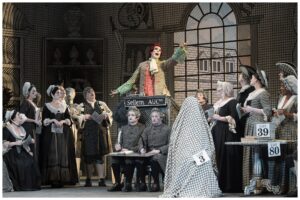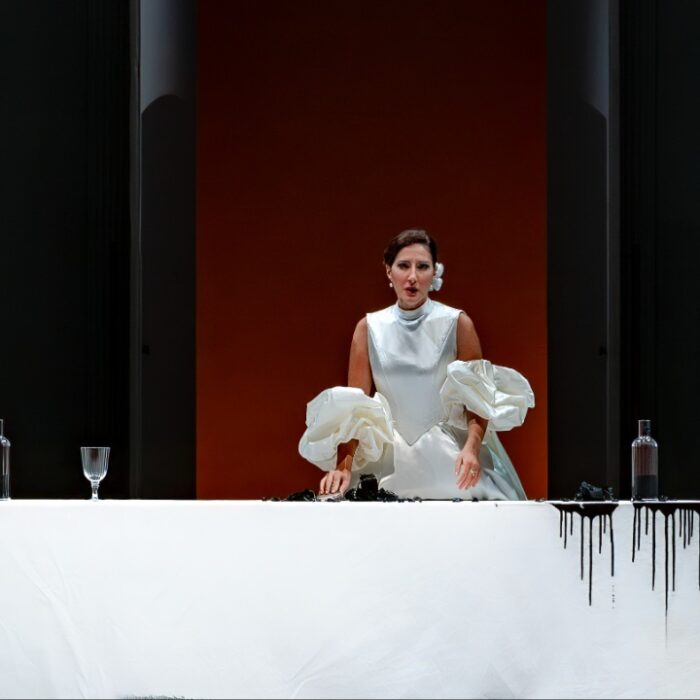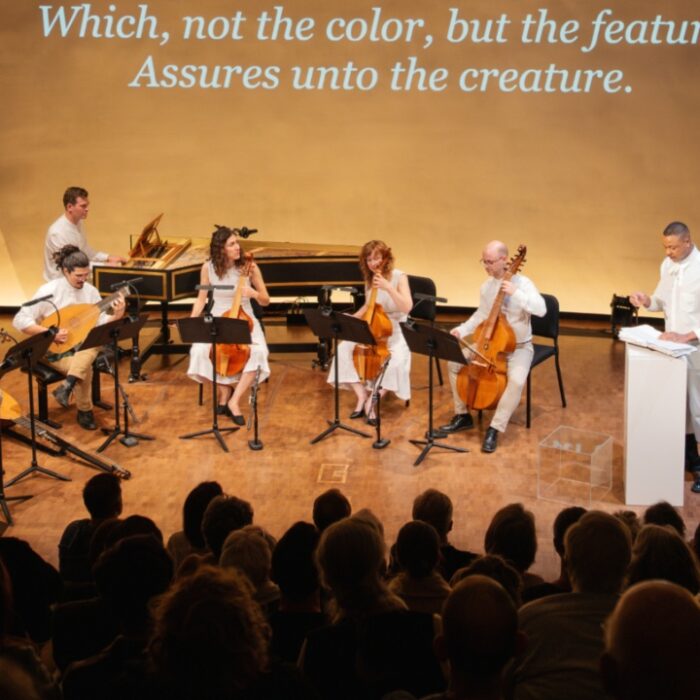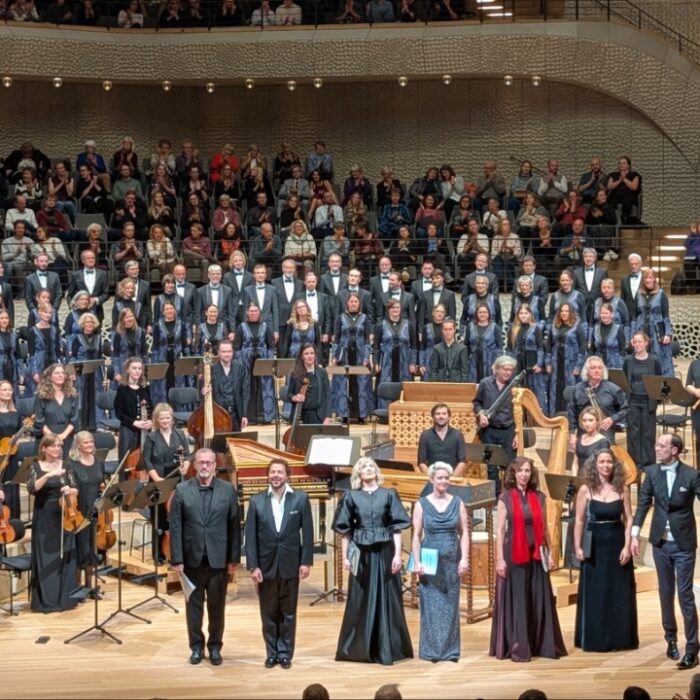
Glyndebourne Festival Opera Review 2023: The Rake’s Progress
Nothing Hackneyed About Hockney’s Designs in 12th Revival
By Benjamin Poore(Photo credit: © Glyndebourne Productions Ltd. Richard Hubert Smith)
John Cox and David Hockney’s production of “The Rake’s Progress” for Glyndebourne can surely lay claim to being the longest-running staging in the UK. It is 48-years-young this season, and on its 12th revival between Festival and Tour, not to mention the numerous loans of the production to international houses of distinction. Presumably, only some of Zeffirelli’s shows for the Met could compete with this level of longevity.
The ovation that greeted Hockney and Cox at the curtain call, spoke of the deep affection both the house and audience have for this extraordinary meeting of artistic disciplines in this particular production. Stravinsky’s chameleon score, W.H. Auden and Chester Kallman’s icily witty couplets, and Hockney’s teeming, taut stage pictures create this.
First Opera Production
Incredibly, it was Hockney‘s first opera production. His visions of “The Magic Flute” and “Tristan und Isolde” have been acclaimed elsewhere since. But, this has established itself as one of the definitive visions of Stravinsky’s morality tale, based on Hogarth’s satirical paintings of the 1730s, which anchor much of the blocking and gesture of Cox’s production.
After nearly five decades, the audience still often gasps when the front cloth rises. Hockney’s experiences in America informed his own Hogarthian set of panels from 1961 to 1963. Despite the eighteenth-century surface of the piece, in both respect for costume and a number-driven score, his experiences reinforce the fact that it is very much a piece about consumerist modernity. Auden and Stravinsky spent plenty of time in the US, of course. They were familiar with decadent, detached, and superficially sentimental airs.
Hockney’s etched sets and costumes fizz with life. Props and furniture are filled in with energetic cross-hatching. The lines are bold and the patterns are geometric. The text snakes about elsewhere in capricious contrast as reason and fancy are held in tension. Cool calculation is punctuated with sudden bursts of sensuousness and energetic comedy. For example, the naughty clock in Mother Goose’s brothel, or Baba the Turk’s crockery-smashing shenanigans at breakfast. It’s the monochromatic scheme of eighteenth-century print that offers an ominous backdrop as one edges ever closer to Tom’s mortal confrontation in the graveyard. The bursts of red and green are reserved for the wild excesses of Tom, as his wealth and turpitude increase. Baba the Turk’s purple beard is a thing of wonder. The prevailing impression is of powerful and striving energies, channeled by sharply-angled raked sets and powerful horizontal lines. Inside all this, is the story of rise-and-decline. It is told as uncomplicated, as one might expect, from a production that debuted in 1975.
There is a serious risk of the design upstaging the opera. However, Hockney’s mix of precision, caprice, and flamboyance was such a perfect filter for Stravinsky’s own aesthetic that this was prevented. The stage pictures were so gasp-inducing and powerful, that they do engender a shift in how we understand “The Rake’s Progress” as a piece of theater. For example, the front cloth serves an important dramatic function. The pauses between scenes, with the anticipation as to what will be revealed and rising each time, create the impression of a set of iconographic panels or tableau. They are fundamentally static, though not undramatic, in nature. We scrutinize the fabulous detailing in much the same way one would Hogarth’s own vibrant cartoons. The front cloth itself primes us to do this, as one turns, with the house lights up, to one’s companion and teases away at Hockney’s arresting images.
We peruse the piece as if in a gallery, with the same kind of detachment Stravinsky’s score has towards its various operatic sources, examined with meticulous intelligence. This is aided by Cox’s unfussy blocking and movement, notwithstanding the vivacious, riotous crowd scenes like the auction or arrival of Baba the Turk at Rakewell’s home. In short, it is an ideal meeting of design, text, and music, albeit one less “immersively theatrical” than other productions of the work. Or, today’s habits of “Personregie,” more generally, which seek psychological immediacy and intensity. Perhaps this is at a hidden cost.
Strong Casting
Thomas Atkins made a very appealing Tom Rakewell. He developed in vocal stature, after a slightly swooping start, as the performance went on. He was an extremely charming performer, bouncing around the stage, or flouncing off with frustration and ennui with verve. His confrontation in the graveyard was among the highlights. Atkins sang with desperate zeal and his tight vibrato wound round notes of steely intensity. Perhaps the most special singing was saved for his scene in the madhouse. Transfigured by delusion into lovesick Adonis, Atkins did wonders with his head voice and falsetto. At times, he was glassily fragile, as if on the cusp of tears. At other times, he was creamy, indulgent and lost in his visions of Venus.
His antagonist is a fruitily-voiced Sam Carl as Nick Shadow. Carl alternates a feathery and ghostly head voice, like something out of Schubert’s “Erlkönig.” He has an inky lower register, that is pungent, indulgent, and more than a little portentous. His top notes, especially in the graveyard scene, were dark and bronzed. He doesn’t steal every scene the way a Shadow can, and is somewhat dramatically chilly. His gestures could be bigger and more generous, especially when he engages directly with the public, to establish the center of charismatic gravity. But, vocally it is a stylish and slithering rendition.
Louise Alder is a perfectly calibrated Anne Trulove. She is a fine foil to the boyish restlessness of Rakewell in her movement and action. Alder is more still and grounded, a center of moral clarity in the tumult. Rather than innocent or childish, Anne’s confidence comes through most in her vocal assurance and strength in her actions and solidity of purpose. “No word from Tom,” saw the character wholly realized. She showed off a wonderful variety of colors. The coloratura in “I go to him” was steely, with decisively-focused top notes, losing no richness or intensity above the stave. An impression of absolute determination was aided by Alder’s cut-glass diction. There was control over her tenderness, too, in a sensational final lullaby, with a feather-soft “Goodbye.”
Alisa Kolosova’s Baba the Turk shared with Anne Trulove a certain wisdom born of experience, alongside her manic patter, and an imperious stage presence. Her machine-gun chatter was hypnotically assured and crisply delivered with a remarkable evenness of tone. After she is uncovered in the auction scene, her mezzo swelled to regal, furious heights. Rupert Charlesworth’s brief turn as Sellem is a cheeky and effervescent delight. He beautifully acted and playfully drew on his supple instrument for a gamut of colors and textures. Carole Wilson’s Mother Goose also put in a commanding turn, the iron matriarch in a velvet vocal glove.
The Glyndebourne Chorus are on lithe form, slimmed down for the neoclassical proportions of the opera, and excelling in the many step-out solos in the auction scene. Indeed, their musical precision, with gnarly harmonies twisted to perfection, is matched by some of the liveliest acting and movement of the evening. Whether in Mother Goose’s brothel or at the auction, the chorus delivers. In the penultimate madhouse scene, they are eerily still in their silos, and equally uncanny in voice. Transfigured by masks, they take on the glassy straight-voiced detachment of a Greek chorus. It is unearthly and pitiful.
Robin Ticciati, Glyndebourne Music Director, returns to the pit with the London Philharmonic Orchestra (LPO) for this revival. This summer and last, in scores by Poulenc, he has shown an intuitive, incisive grasp of postwar neoclassicism. Stravinsky’s score, all piquant harmonies and arch lyricism, wants both wit and smoothness, never letting the stylistic clothes the composer puts on at various points to become gaudy pantomime. Hockney’s designs, also, are too precise for that. Smugness and pantomime in its musical realization, “oh, I understand that reference,” robs the piece of its real heartfelt moments and slackens the drama’s tautly-conceived themes.
Ticciati’s account is poised and polished. It is never garish funhouse-mirror stuff. Although, it could stand for some of the same angularity and sharpness in attack and textural contrast as Hockney’s stage picture, channeling his wonderful cross-hatching. The string playing is cool and the score’s lyricism beguilingly detached, though never without heart or tenderness. This is especially in the refrains of “Gently, gently little boat.” Playing from the LPO is expectedly exacting, with an especially pensive trumpet solo narrating Anne’s arrival at Rakewell’s house, and a molto semplice flute solo in Anne’s lullaby. Matthew Fletcher’s harpsichord playing, maniacal in the graveyard confrontation, was absolutely scintillating. Glyndebourne’s “Rake’s Progress” will be 50 in 2025 and it seems certain to remain a regular fixture long beyond it.



